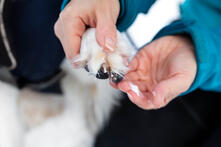Invisible danger for dogs in winter: Road salt and grit
The temperatures are slowly dropping, it's white outside and sometimes the world seems to stand still. Inside, candles are burning - it's winter in Switzerland. When it storms and snows, usually only one group of people trudges bravely through the snow - we dog lovers. We know, the dog has to relieve his full bladder even when it is storming and snowing outside. And already the dog is confronted with a - even sometimes transparent - danger.

What are road salt and grit?
All these terms can be summarized under the generic term "winter grit". Road salt are chemical substrates, which are not always visible at first sight. They are mainly used on cleared roads. Even seemingly clean snow on the edges of sidewalks may contain deposits of these substrates. In addition, road salts can contain portions of antifreeze - these stimulate the dog by an appealing smell and taste all the more to pick up contaminated snow.
How does the dog absorb these substances?
The dog can absorb these substances on the one hand by eating snow, but also by licking paws and fur.
What symptoms can the dog show?
The dog may react with diarrhea, vomiting and fever. In this case, it is necessary to immediately consult the veterinarian. If the dog ingests too much of these substrates, it can die! Especially in small dogs, a vanishingly small amount of these toxins is enough and the dog dies.
The dog may also start limping or completely refuse to walk any further. In this case, the road salt probably tore up his paws. Reddened paws, inflammation or even eczema on the paws can also occur.
Important: The dog may react with diarrhea, vomiting and fever when ingested. In this case, it is necessary to immediately consult the veterinarian.
Most important prevention measures
Coat Care: In winter, keep long hair and tufts of fur under paws short (trim with scissors or with help from your trusted groomer).
Paw wax: Special care products from the specialized trade protect the paws. For example, petroleum jelly or milking grease is also suitable. The protective layer helps prevent salt from penetrating the skin too quickly or prevents rapid formation of lumps.
Shoes: A possibility anerbietet itself with Booties (dog shoes). There are various models available in specialized stores, in all possible shapes, sizes and colors. Wearing these utensils must be trained with the dog most of the time. Associate the shoes with something positive - for example, by giving a treat, after each successfully attached shoe. Let the dog practice and try walking indoors.
On the way walking
Avoid heavily gritted roads and paths: better to avoid snowy areas
Do not eat snow: Try to keep the dog from eating snow. Do not throw snowballs, this can quickly cause gastrointestinal upset even without road salt.
Arrived at home:
Wash paws: Wash each paw individually with lukewarm water after each walk. Do not use soap or similar products, as this will dry out the skin even more. Afterwards, the paws should be examined for cracks, redness and stuck grit. The pads and the paw skin can then be cared for with an ointment for paw care from the specialist trade.
We wish you a great winter with many beautiful and wintry impressions. Inspiration for a winter excursion can be found under the heading "on the road" - winter hikes .
(Contribution H-und.ch/ Céline Bernasconi, 14.12.22)




